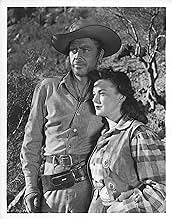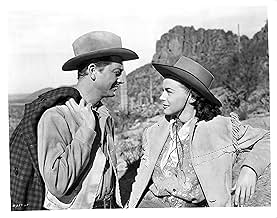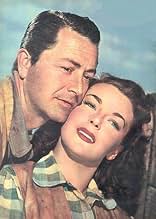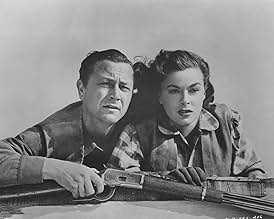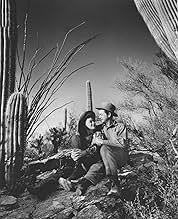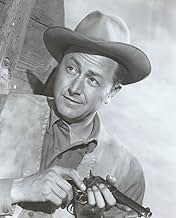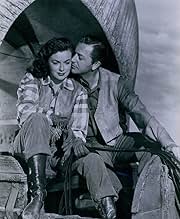Framed for a murder he didn't commit, a cowboy must stay one step ahead of the law as he hunts for the real killer.Framed for a murder he didn't commit, a cowboy must stay one step ahead of the law as he hunts for the real killer.Framed for a murder he didn't commit, a cowboy must stay one step ahead of the law as he hunts for the real killer.
- Director
- Writers
- Stars
- Awards
- 4 wins total
Ernie Adams
- Barfly
- (uncredited)
Victor Adamson
- Barfly
- (uncredited)
Robert Barron
- Rupple's Brother
- (uncredited)
Roy Brent
- Card Player
- (uncredited)
Paul E. Burns
- Len Briggs
- (uncredited)
Johnny Carpenter
- Deputy Johnny - Posse Member
- (uncredited)
John Cason
- Deputy Posse Member
- (uncredited)
Victor Cox
- Deputy
- (uncredited)
- Director
- Writers
- All cast & crew
- Production, box office & more at IMDbPro
Featured reviews
Although Marguerite Chapman does fine yeoman work in her obligatory generic love interest role, the show is the pursuit of Young after horse thief MacLane. And, it is a fast-paced, cat-and-mouse entertaining game in which protagonist and antagonist take turns revealing their thoughts and feelings in a most involving way. This is certainly not a classic "B" western, but it is entertaining from beginning to end and very fast paced.
When you think westerns, Robert Young seldom comes to mind. As an actor, he was more at home in TV's white-collar world of suburbia or a doctor's office. At the same time, he knew his limitations and never tried to be the swaggering tough guy. Here, he low-keys his role perfectly. With the help of a girl drummer, a foal, and a burro, he's tracking a guy across the desert who can clear him of a murder charge. Chapman does well as the stand-up girl, while she and Young manage several charming scenes together.
All in all, it's a rather affecting little outdoor western, made at a time when horses and dogs were popular movie fare. Here, the two critters are blended nicely into the main plot, and I like the way the foal disappoints expectations by growing into a rather homely, undersized adult. That seems to say, a critter doesn't have to be big and beautiful—as in most movies-- to be worthy of affection. Note too, how Nick (Young) challenges convention by talking up women's equality at a time when Westerns-- more than most genres-- held women to domestic roles.
Also, there's an absolutely stunning Technicolor sunset about two-thirds of the way through that's the equal of any postcard framing I've seen. Plus, take a gander at all the movie's crusty old coots, Wright, Bevans, Patterson, et al., which seems to be missing only Gabby Hayes in its Hollywood lineup. Not everything however is roses. I could have done without the rather clumsy Tamiroff-Mazurki subplot, while the logic of some events does remain a stretch.
Nonetheless, this handsome Columbia programmer remains good family fare, even 60-years later.
All in all, it's a rather affecting little outdoor western, made at a time when horses and dogs were popular movie fare. Here, the two critters are blended nicely into the main plot, and I like the way the foal disappoints expectations by growing into a rather homely, undersized adult. That seems to say, a critter doesn't have to be big and beautiful—as in most movies-- to be worthy of affection. Note too, how Nick (Young) challenges convention by talking up women's equality at a time when Westerns-- more than most genres-- held women to domestic roles.
Also, there's an absolutely stunning Technicolor sunset about two-thirds of the way through that's the equal of any postcard framing I've seen. Plus, take a gander at all the movie's crusty old coots, Wright, Bevans, Patterson, et al., which seems to be missing only Gabby Hayes in its Hollywood lineup. Not everything however is roses. I could have done without the rather clumsy Tamiroff-Mazurki subplot, while the logic of some events does remain a stretch.
Nonetheless, this handsome Columbia programmer remains good family fare, even 60-years later.
Sizzling and exciting adventure Western with drama , frantic action and breathtaking ending shoot'em up. At the local saloon, prospectors Len Briggs and Bob Pliny brag about encountering gold at their mine . Badmen Tex Brandaw (Barton McLane) and Jim Rupple (Frank Fenton) decide to follow the two prospectors and rob their mine. Drifter Nick Buckley (Robert Young) who's passing through town seeking shelter for his pregnant mare is offered a drink by the two old prospectors . The prospectors return to their cabin and in an ambush two villians kill them and take the map revealing the gold mine's location. They divide the map in two sections , to prevent cheating , and split up agreeing each other and to meet after that . Then , the sheriff shows up and he charges Nick for the murders of the two gold prospectors . Framed for the killing and with a reward on his head , Nick flees and he runs into Luella Purdy (Marguerite Chapman) , a travelling seller . She agrees to help Nick care for his hungry foal and to transport him across the sunny desert . Throughout the dangerous paths the expedition carrying some clues about the gold mine , being chased by a posse , by cuthtroat bounty hunters and by two ambitious bad guys : Joe Faringo (Akim Tamiroff) and Jake (Mike Mazurki) . Violence ... love ... and sudden death ! The cry that rooked the world'd hottest strip the hell ¡.
A Western drama with dramatic moments , noisy action , shootouts , crosses, romance, luxurious photography and a highly commendable musical score . Bursting with attractive characters, interesting sub-plots , and with very decent filmmaking, as well as fine interpretation, and brief drops of humor in charge of a mare and a donkey . Robert Young gives a nice acting as an accused person for a murder he didn't commit, as the brave cowboy must stay one step ahead of the law as he hunts for the real killer. Robert Young did play in the Thirties and Forties as many as eleven films per year for a decade starting with Black Camel (1931). He was notable as the spy in Alfred Hitchcock's Secret agent (1936), but the '40s was the decade in which he was to have most of his best roles. These included Northwest passage (1940) with Spencer Tracy ; Fritz Lang's Western Union (1941) with Randolph Scott ; and H.M. Pulham, Esq. (1941). Good roles followed, from the husband of Dorothy McGuire in Claudia, (1943) to the detective in Crossfire (1947) by Edward Dymitrick but they were becoming scarce. He starred notorious films as The big moment , And the baby makes three , The searching wind and The secret of Incas . In 1949, Robert started a radio show called "Father Knows Best" wherein he played Jim Anderson, an average father with average situations--a role which was tailor-made for him. Basically retiring from films, he starred in this program for five years on radio before it went to television in 1954. After a slight falter in the ratings and a switch from CBS to NBC, it became a mainstay of television until it was canceled in 1960. He continued making guest appearances on various television shows and working in television movies. In 1969, he starred as Dr. Marcus Welby in the TV movie Marcus Welby: A Matter of Humanities and another successful series : Doctor Kildare . Co-starring is Marguerite Chapman who plays very well as Luella Purdy, owner of a traveling general store, whom Nick met into town the day, subsequently both of them fall in love. They are well supported by a pretty good secondary cast , such as : Willard Parker as Jeff Moyer , Akim Tamiroff as Joe Faringo , Barton MacLane as Tex Brandow , Mike Mazurki , Robert Barrat , Frnk Fenton, Clem Bevans, among others .
It contains thrilling and moving musical score by Marlin Skiles . Colorful cinematography in Technicolor by Edward Cronjager . Being shot in multiple locations such as While Mountains , IronWoods ,Silver Bell Mountains, Arizona, Tucson Mountains, Sedona, Kinney Road, Tucson, Arizona, Ray Corrigan Ranch, Simi Valley, California. This modest drama/action/Western picture was professionally and firmly directed by George Sherman , though slowly filmed, at times, I miss more action and shots, but it also has pursuits and impressive finale duel . The movie was a collaboration between Eugene B. Rodney Productions and Columbia Pictures , supported by the prestigious craftsman fimmaker Sherman . And screenplay by prestigious Winston Miller , based on a story titled "Three Were Thoroughbreds" by Kenneth Perkins . The motion picture was competently directed by George Sherman in B-style , though it has some flaws . Entertainment , atmosphere , action and excitement surge along with the tale under the hand of a good filmmaker George Sherman , who is clearly more at home with the thrilling scenes than with somewhat excessively talking storyline . Sherman made reliable low-budget fare for Columbia between 1945-48, then moved on to do the same at Universal for another eight years , where he directed ¨War Arrow¨ . Sherman specialized almost exclusively in "B" westerns there , including the "Three Musketeers" series, which featured a young John Wayne. George directed lots of Westerns as ¨The Last of the Fast Guns¨ , ¨The Lone Hand¨, ¨Santa Fe stampede¨ , ¨Red skin¨ , ¨Chief Crazy Horse¨ ¨Calamity Jane¨, ¨Relentless¨ , ¨Comanche Territory¨ , ¨Dawn at Socorro¨, ¨Border River¨ and many others . He also made occasional forays into action and horror themes, often achieving a sense of style over substance . The only "A"-grade films to his credit were two westerns starring John Wayne: ¨Comancheros¨ (1961) (as producer) and ¨The big Jack¨ (1971) . His last films were realized in Spain as "Find That Girl" , ¨The new Cinderella¨ and ¨Joaquin Murrieta¨. Rating : 6.5/10 . Acceptable and passable Western . Well worth watching.
A Western drama with dramatic moments , noisy action , shootouts , crosses, romance, luxurious photography and a highly commendable musical score . Bursting with attractive characters, interesting sub-plots , and with very decent filmmaking, as well as fine interpretation, and brief drops of humor in charge of a mare and a donkey . Robert Young gives a nice acting as an accused person for a murder he didn't commit, as the brave cowboy must stay one step ahead of the law as he hunts for the real killer. Robert Young did play in the Thirties and Forties as many as eleven films per year for a decade starting with Black Camel (1931). He was notable as the spy in Alfred Hitchcock's Secret agent (1936), but the '40s was the decade in which he was to have most of his best roles. These included Northwest passage (1940) with Spencer Tracy ; Fritz Lang's Western Union (1941) with Randolph Scott ; and H.M. Pulham, Esq. (1941). Good roles followed, from the husband of Dorothy McGuire in Claudia, (1943) to the detective in Crossfire (1947) by Edward Dymitrick but they were becoming scarce. He starred notorious films as The big moment , And the baby makes three , The searching wind and The secret of Incas . In 1949, Robert started a radio show called "Father Knows Best" wherein he played Jim Anderson, an average father with average situations--a role which was tailor-made for him. Basically retiring from films, he starred in this program for five years on radio before it went to television in 1954. After a slight falter in the ratings and a switch from CBS to NBC, it became a mainstay of television until it was canceled in 1960. He continued making guest appearances on various television shows and working in television movies. In 1969, he starred as Dr. Marcus Welby in the TV movie Marcus Welby: A Matter of Humanities and another successful series : Doctor Kildare . Co-starring is Marguerite Chapman who plays very well as Luella Purdy, owner of a traveling general store, whom Nick met into town the day, subsequently both of them fall in love. They are well supported by a pretty good secondary cast , such as : Willard Parker as Jeff Moyer , Akim Tamiroff as Joe Faringo , Barton MacLane as Tex Brandow , Mike Mazurki , Robert Barrat , Frnk Fenton, Clem Bevans, among others .
It contains thrilling and moving musical score by Marlin Skiles . Colorful cinematography in Technicolor by Edward Cronjager . Being shot in multiple locations such as While Mountains , IronWoods ,Silver Bell Mountains, Arizona, Tucson Mountains, Sedona, Kinney Road, Tucson, Arizona, Ray Corrigan Ranch, Simi Valley, California. This modest drama/action/Western picture was professionally and firmly directed by George Sherman , though slowly filmed, at times, I miss more action and shots, but it also has pursuits and impressive finale duel . The movie was a collaboration between Eugene B. Rodney Productions and Columbia Pictures , supported by the prestigious craftsman fimmaker Sherman . And screenplay by prestigious Winston Miller , based on a story titled "Three Were Thoroughbreds" by Kenneth Perkins . The motion picture was competently directed by George Sherman in B-style , though it has some flaws . Entertainment , atmosphere , action and excitement surge along with the tale under the hand of a good filmmaker George Sherman , who is clearly more at home with the thrilling scenes than with somewhat excessively talking storyline . Sherman made reliable low-budget fare for Columbia between 1945-48, then moved on to do the same at Universal for another eight years , where he directed ¨War Arrow¨ . Sherman specialized almost exclusively in "B" westerns there , including the "Three Musketeers" series, which featured a young John Wayne. George directed lots of Westerns as ¨The Last of the Fast Guns¨ , ¨The Lone Hand¨, ¨Santa Fe stampede¨ , ¨Red skin¨ , ¨Chief Crazy Horse¨ ¨Calamity Jane¨, ¨Relentless¨ , ¨Comanche Territory¨ , ¨Dawn at Socorro¨, ¨Border River¨ and many others . He also made occasional forays into action and horror themes, often achieving a sense of style over substance . The only "A"-grade films to his credit were two westerns starring John Wayne: ¨Comancheros¨ (1961) (as producer) and ¨The big Jack¨ (1971) . His last films were realized in Spain as "Find That Girl" , ¨The new Cinderella¨ and ¨Joaquin Murrieta¨. Rating : 6.5/10 . Acceptable and passable Western . Well worth watching.
This is a well made western that star Robert Young also produced. It includes three solid performances by Young, Marguerite Chapman and Barton MacLane. There is also a fun and somewhat poignant subplot involving a burro and a colt that is most unique. The title comes from the fact that Young's character never gives up in his pursuit of finding a killer. Chapman is highly engaging and real as she stands by her man (Young)with evidence to the contrary. Highly recommended. (Oh, watch for the appearance by Willard Parker as the sheriff. In a scene, towards the end, his physique and attitude remind you that he would have made a pretty good Lone Ranger if the commanding Clayton Moore hadn't been around.)
I was really geared up to enjoy this Western. It was high-class and adult in just about every way -- the acting, dialog, photography, scenery, cast, etc. Everything that is except the story. It soon became very boring; I couldn't wait for the movie to end. I fast-forwarded through some scenes. One thing that got on my nerves was the way in the wide open spaces of the desert West, the hero continually came across his lady friend and the bad guys by chance and how the characters could follow and track other characters so easily in the wide open spaces. Even the bad guy confessed on cue at the end by chance and coincidence. Even the evidence against the hero was rather flimsy. Too bad, for it was well-intentioned with good production values.
Did you know
- TriviaOn June 7, 1948, Lux Radio Theatre presented a radio broadcast of the story, starring Robert Young and Claire Trevor.
- GoofsWhen Robert Young is in canyon chasing bad guy he touches a cholla cactus. The cholla is remarkable for the ease with which it sheds its spines and he should have been covered in them.
- ConnectionsRemade as Qui est le traître ? (1953)
Details
- Runtime1 hour 33 minutes
- Aspect ratio
- 1.37 : 1
Contribute to this page
Suggest an edit or add missing content

Top Gap
By what name was Du sang dans la sierra (1948) officially released in India in English?
Answer
